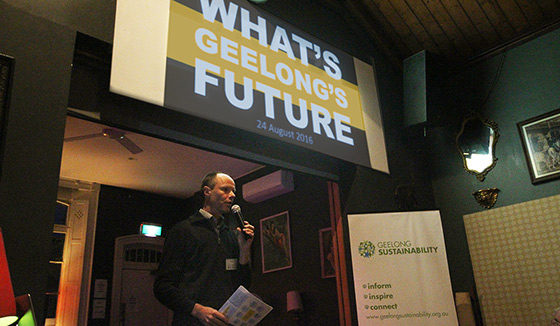
Mik Aidt’s presentation at the Geelong Green Drinks on 24 August 2016
» Suggestion: Start the player and listen while you take your time to browse through the photos below
An audio recording of a ten-minute group workshop at the end of the presentation can be found further below.
In Geelong, we are going to be talking about the future. The long-term future of our city – looking 20-30 years ahead, and we will be asking ourselves: what would we like our city to look like then? Are we getting The Big Picture right?
I can promise you this with a bit of certainty – that we will be engaging in a broad conversation about our city’s long-term future – because the City of Greater Geelong Council has just started a process facilitating such a conversation, with an ambition to involve and engage at least 25,000 residents in it. It is a year-long community consultation process called ‘Our Future’, starting out on 1 September 2016 with a futurist meeting at GPAC.
In Geelong Sustainability and in The Sustainable Hour on 94.7 The Pulse, so much of what we generally talk about is already focused on how we are able to shape our future into a more healthy, sustainable and environment-friendly direction. So here is, all of a sudden, an invitation to take that conversation to a new level and in some new directions involving new groups of residents of this city… How exciting is that?!
I think it offers a great opportunity for anyone working with transforming Geelong into a cleaner, greener and more liveable city. If we want to see change, we need both vision and ambition. And such vision will not come out of nowhere all of a sudden – we have to take a look out and see what other cities are doing at the moment, in Australia as well as other places in the world: where are the success stories? Where are the good ideas we could copy or learn from?
With this presentation, held at Beav’s Bar on 24 August, and loosely illustrated below as well, I hope to give some inspiration for the opening of that process. Because, as Dr Kathy Alexander, the city council’s Chair of Administrators, told us last week in The Sustainable Hour, this process is not only about residents telling council what they think – it is also a process which invites residents to be educating themselves about what successful, liveable and prosperous cities elsewhere on this planet look like, and what it was that triggered that success.
In some ways I feel like I have just come back from the future. I have seen some glimpses of what the future of Geelong maybe could look like. Two weeks ago, we got back from a two-months trip to Denmark, and before we talk more about the future, let me give you some inspirational snapshots of what Denmark looks like today.
This is what the little North European country looks like on a map:
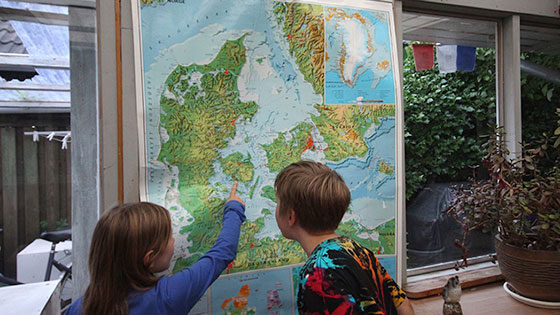
Measured in square kilometres, the place is around 175 times smaller than Australia. Even so, the Danes have found room for raising over 12 times more wind turbines than the Australians have raised so far.
In terms of people, there are about as many people in Denmark as in Victoria: 5.5 million.
Arrival
The minute we arrived, we already felt some sound, green vibes as we entered the baggage reclaim hall in Copenhagen Airport – because of this official welcoming cyclist-billboard from the City Council, saying “I cycle Copenhagen” – providing a place to pump the wheels of your bicycle, should you have brought one with you in the luggage.
“Every day, locals in Copenhagen bike 1,340,000 kilometres, the equivalent to 31 times around the Earth! Feel free to join…
City of Copenhagen”
Three things instantly stand out when arriving to Denmark as a tourist. In recent years, Denmark has become a world leader in each of these three fields: Denmark is…
1) a bicycle-country
2) a wind-country
3) becoming an organic country (the Danes call it “ecological”)

Another thing you notice right from the windows of the arrival hall in the airport is that the Danes are busy with digging big holes in their streets and laying huge pipes which can transport storm water away.
The Danes are already experiencing climate change, and responding to that experience.
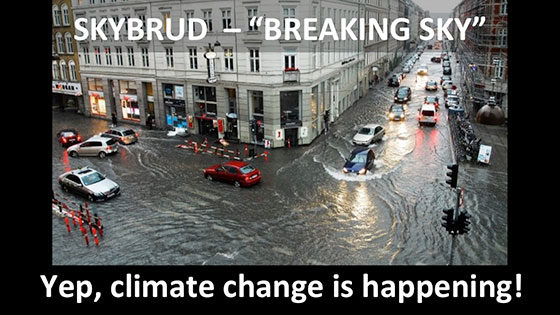
Tumultuous incidents of flash flooding are becoming more and more frequent – in Danish language the phenomena is called ‘Skybrud’, which means something like that “the sky is breaking”.
As a consequence of this, municipalities, housing companies and individual house-owners are currently investing huge sums of money in protecting their properties and roads against the flooding. In every city in the country, more or less, traffic is being interrupted by this kind of massive road works:


….and as it says on this sign, since they are at it with the digging and opening up the streets, the Danes use this opportunity to also put some pipes for transporting hot water in the ground, expanding the already extensive district heating system, which keeps something like 90 per cent of all houses in Copenhagen warm with “recycled” heat from industry and waste-to-energy systems.

The Danes are talking high and low about becoming “energy-right” – energy efficient – and in the City of Copenhagen everyone is installing systems that can ensure that the city will reach its goal of becoming the first carbon-neutral capital in the world.
Denmark has 77 ‘climate-friendly’ municipalities, meaning: municipalities where the city council has decided to set a carbon-neutral goal for the municipality and to invest in renewables.
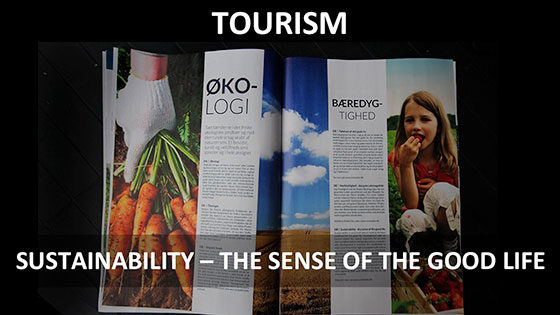
What struck me when I’d be opening a tourist brochure or a magazine about Denmark was that organic foods and sustainability is marketed everywhere as an important aspect of what Denmark has to offer.
One headline in this tourist magazine, which is in both German, English and Danish language, says: “Sustainability – the sense of the good life.” And that really is how many Danes feel around these topics: it is not only about protecting the environment or doing something good for the climate, it is also simply about creating a “sense of the good life.”
Denmark is a bicycle-country
Cycling is fun in Denmark, and it is safe. It is safe because there is safety in numbers, and you see cyclists everywhere, and the cycling infrastructure keeps getting expanded and improved. Cycling is promoted by the municipality as the smart way to get around in the city. And it is fun, too, because of those fancy bridges, among other things, that create shortcuts where cars can’t go:
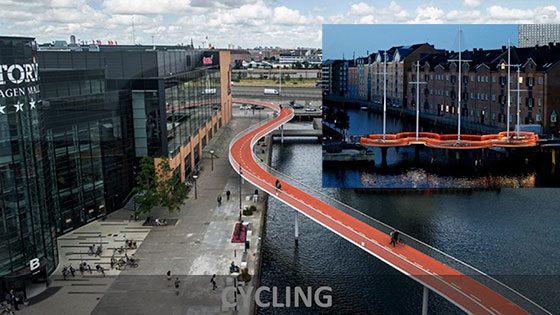
Cycling means business
More than half of the population in Copenhagen jump up on their bicycles to transport themselves to school or to work every day. Cyclists’ short distance-trips are interesting – or: ought to be considered interesting – in an Australian city-planning context, because they mean business, according to Danish researchers:
“Cyclists and pedestrians contribute to roughly 50 per cent of the revenue in retailing in the large cities’ centers. The bicycle is the preferred means of transportation in city centers, and cyclists visit more shops per trip than car drivers,” writes Rune Monberg Dalhof from the Danish Cyclists’ Federation in an article posted posted on State of Green, a government enterprise.
Rune explains how cycling has become such an integral part of The Danish Story, and he has gathered some of the solutions that shaped the narrative on www.stateofgreen.com
Helmet freedom
On warm summer days, adult Danes appreciate their freedom of not being forced to wear a helmet. In the European countries adult bike riders are generally treated like responsible adults allowed to make their own decisions about when to use a helmet, and when to not to.
It makes you inclined to jump up on that bike a lot more often, in particular for short distances, and in particular for shopping and going out on a social occasion. As soon as wearing that helmet is made compulsory by law, as it is in Australia, with a threat of being fined hundreds of dollars if you forget it, then it becomes a prison. And it becomes yet another factor to keep people away from using those bikes for the daily transport purposes.
Don’t get me wrong: I like helmets. In Denmark, I wear one myself when I think it is appropriate. For instance when I go for a six kilometre fast ride in the traffic through town. What I dislike is when lawmakers take away my freedom to choose. The main reason why I don’t think helmets should be mandatory is the same, I guess, why some people think they should be allowed to smoke cigarettes, even though they are fully aware of the dangers it implies. If cyclists are to be forced to wear helmets, why aren’t car drivers? Shouldn’t this mandatory safety principle apply for everyone in the traffic? Again, why are cyclists being discriminated?
A cycling library
Below is an example of modern public service in Denmark with a sense of ‘generous taxpayer-funded citizen service’: An open air library at the beach, transported there from the library building with a cargo bike.
The local library use their ‘library bike’ to move a selection of its books to the beach on sunny days. What a great place to discover new knowledge and entertainment.
‘KULTUR PÅ TUR’, as it says on a sticker on the bike, means ‘Culture on tour’, or ‘Culture on the road’
‘City of Bicycles’ – in 1937
“Automobiles appear to be very much out of place here, where cyclists have the right of way by an overwhelming majority,” says the speaker at 8:20 in this film from 1937
More about cycling
Three of my previous blogposts about cycling:
» Call for more cyclists in the streets
» The real value of cycling
» In a Danish cyclist’s perspective: What is wrong in Geelong
Blogposts on this site tagged Cycling
2)
Denmark is a wind-country
… and proud of it. You see wind turbines all over the place, and in particular on the country’s west coast, where it is often very windy.
Tourists flying in to Copenhagen usually make notice of the city’s impressive ‘wind-skyline’ already before putting their feet to the ground in the airport.
Here is a part of it, as seen from its city beach on Amager:
Wind power means clean air – electricity without air pollution – and it also means business and jobs in Denmark. For instance, just in the second quarter of 2016, the Danish wind turbine company Vestas announced orders from nine countries to build 1,124 MW of turbines. » www.facebook.com/vestas/photos
On 6 August 2016, we observed how the Danish wind turbines were happily turning in the strong wind – in particular on the west coast of Jutland, facing the sea. On this particular afternoon, wind and solar power in Denmark generated 20 percent MORE power than the Danes consumed: www.facebook.com
And this is how they store the extra energy, by using it to pump water up in the Swedish and Norwegian mountain lakes. On days with less wind, the Swedish and Norwegian hydro generators turn the flow of the water back into electricity:
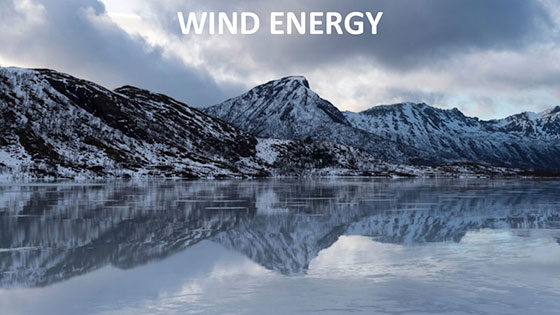
The photo below shows the wind turbine park in Tjæreborg Enge which is situated right next to a bird reserve. Contrary to what Australians are made to believe, birds and wind turbines coexist much better than birds and cars – not to mention birds and polluting coal-fired power plants – do.
The bird reserve is situated some 500 metres from the wind park.
According to Australian rumours and myths, dead birds would be piling up at the bottom of the wind turbines, so we actually went and checked to see if we could find any. We had already heard from the Danish Ornithological Society that they found this not to be the case. And… at the two turbine towers we checked, we found some snails and some litter, but not a single dead bird.
A quote from Danish Ornithological Society’s home page: “Thus it turned out that the big wind turbines in Tjæreborg Enge, only a few hundred meters from the bird reserve, has no impact on the large number of resting birds in the vicinity, and the actual collisions with passing migrating birds is minimal.”
www.dof.dk
…and then there is the NOISE! Another complaint against large wind turbines is that the noise from the wind turbine blades makes people sick. In Australia, fear is stirred up by lobby groups, and protest meetings are organised to stop new wind turbine projects. Whereas people have lived for centuries right next to the Australian airports, right under the flight routes, and no one is complaining there.
There are so many ridiculous myths. Like the one that wind farms should be discouraging tourists.
That didn’t seem to be the case in Hvide Sande – a tourist town on the Danish west coast, full of happy surfers and beach goers. Three impressive, huge wind turbines stand at the harbour, right at the beach, and they don’t seem to bother anyone, really. On the contrary, we saw tourists making selfies in front of them.
And has anyone bothered to ask what the research on this issue says – whether wind farms are discouraging tourists? “Not at all!”, say the researchers. This study concluded there is no ‘detrimental effect’ on the number of holidaymakers in places with wind turbines. » Source: www.independent.co.uk
Looking at how the Danes live with their wind turbines, how they have surrounded their houses with them, or placed them at cities’ waterfronts, they certainly don’t seem to fear getting “sick” from living close to them.
People often talk about how important the Adults School movement, Højskolebevægelsen, has been for the integration of wind turbines in Denmark, for making them so popular during the 1970s and 1980s. For instance the adults school Tvind raised a large wind turbine which became very famous.
The most important reason that you see so many wind turbines on the countryside in Denmark is probably that the farmers and house owners owners benefit economically from them.
Maybe it has to do with that in this country, windmills have been around for centuries, and they have always been regarded as both aesthetically beautiful and beneficial to the community.
I met a man who has worked with large wind turbine manufacturers such as Vestas and Siemens, and he told me that the experiments in Denmark with harnessing electricity from the wind already started already in the 1800s. We’ve always had the old windmills standing highly visible on hills all over the country which would help the farmers grind their cereals – rye, oats and so on – to flour.
In the adventure park Legoland wind turbines are situated as an integrated part of the city infrastructure – just as close to city and beach life as we have see it in real life all over Denmark
And there are Danish organisations such as Wind People, which works actively with creating public engagement and ownership in the wind turbines.
Thousands of individual Danes clearly take pride in producing electricity without polluting the air. The general feeling I got from people I have talked with is that they regard wind turbines as a great way to produce electricity – and earn money.
Also, wind turbines are part of a positive narrative here – for instance in a Danish children’s ‘super hero’ series on national tv. Here is a screen-shot from the popular tv series ‘Motor Mille og Børnebanden’.
3)
Denmark: a world leader in organic food
A Danish newspaper declared Denmark as the leading organic country in the world, with almost a tenth of all food sold in Denmark being organic. Sales of organic goods have doubled over the last ten years, and stores are booming with organic goods, and organic restaurants and cafés are mushrooming.
Mainstream supermarkets market and pride themselves with their support of the organic movement. “We are proud of all the organic goods we feature,” the German supermarket chain Aldi is saying in a radio ad which is aired in high rotation on commercial stations. And the Danish supermarkets recently declared a permanent ban on ‘cage eggs’ – the (cheaper) eggs from chicken in small cages.

Along with this development, the supermarket chain COOP has started focusing on selling local food in its stores and foresees handing local food over the counter at the value of over $300 million a year by 2023.

Let me introduce you to just five examples of the kind of community-active, energetic and optimistic Danes that I met and who all gave me some great stories and something to think about:

Creativity and private entrepreneurship
Creativity and entrepreneurship at an individual level is booming and bubbling in Denmark, Ivan Nielsen told us, who himself is a dynamic builder and inventor, currently transforming an old petrol-boat into a houseboat-restaurant.
“Danes are as tired of politicians and how democracy fails to address the real issues such as protecting our water, our climate and our future, here as everywhere else in the world,” Nielsen explained, “so a lot people have started to take action on their own, and they are being very creative. Amazing projects are mushrooming all over Copenhagen.”
By the end of 2016, this will be the busy kitchen area of a beautiful, sustainable and organic floating restaurant, Ivan Nielsen and his partner Dorrit Saietz tell us. The menu will include brunch, lunch, fine dining, slowfood cooked on a wooden stove, natural wines, wine-tasting, small concerts and other events.
In the summertime they will grow some of the fresh herbs and vegetables right on board, and they will have facilities for swimming in the clean water of Copenhagen Harbour.
Copenhagen South Harbour, where the restaurant will be ‘parked’, is soon going to be the home of a new neighbourhood known as the ‘Canal City’ of Copenhagen. Already now the area is worth a visit in it’s own right.
The name of their new restaurant – ‘Vandvid’ – translates in two ways: ‘WaterWide’ and ‘Crazy’. Chosen because the trio behind the project are, as they write on their home page, “three slightly crazy and creative souls, who are making this dream come true together.”
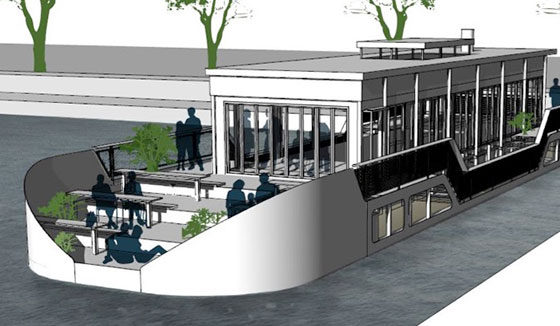
Restaurant Vandvid is currently temporarily parked at the North Harbour.
» You can see photos and drawings on www.vandvid.com
» And more on www.facebook.com

Ivan Nielsen is a busy Dane. Through 40 years, he has run the contracting and construction company Nature’s Workshop (Naturens Værksted). He is joiner, carpenter, bricklayer, stonemason, blacksmith, oven-builder, pipe fitter and designer. He is also a bit of an artist and inventor, and has, among other things, developed a new and revolutionary garden tool called the Garden Scepter.
Ivan has previously run a health food store and held courses about vegetarian food. He claims to be making the city’s best celery beef.
» Videos about the Garden Scepter: www.gardenscepter.net/#!videos/lrseq
» Home page: www.gardenscepter.net

Jan Hugo Schmidt is another Danish man with several interesting and selfmade sustainable dreams in the area of creating a cleaner and greener world. Currently he is occupied with developing a crowdfunded prototype microwave weed-killer which can make organic food cheaper while protecting our drinking water from pesticides.
The Danish prototype is based on research from an Australian university, which shows that microwaves are ideally suited for pesticide-free and safe weed control. At University of Melbourne, Senior Lecturer at Faculty of Veterinary and Agricultural Sciences, Dr Graham Brodie has spent more than 10 years developing and testing the ideas. When the first Danish prototype is built, it combines the Australian research results with a South Jutlandish company’s practical experience through 25 years of working with microwave ovens for the industry.
The new machine is expected to come to market for private customers in two years’ time. The developers expect great interest from the public sector for the machine that promises to halve the municipalities’ annual costs to pesticide weed control, thereby saving tax payers’ money.
Over time, the machine could revolutionise weed control in organic farming. This could mean that we get cheaper organic foods and more conventional farmers will become organic farmers.

Enter Nicolas Vallat, a man full of great ideas. First he started Climate Leave – a simple idea about allowing employees to take off a period of time to spend some time caring for the planet – in a parallel way to how maternity leave is organised, with economic participation from both the union, the employer and the employee.
Now, Nicolas is busy with setting up the first Empty Office Day in Denmark – an initiative to provide employees a respite where it is possible to reconnect with nature, create relationships, learn together to build free and strong communities, to get closer to thoughts about how we can best take care of the earth – and each other.
In this radio interview with Nicolas Vallat, he explains about ‘Empty Office Day’:
“It is about job satisfaction, commitment and relationships. Empty Office Day is a day where you can allow yourself to care – about yourself, your nearest and the environment. Can you convince your boss to hold an Empty Office Day?”
ABC for mental health
A. Do something active
B. Do something together
C. Do something meaningful
and D. Do it during working hours!
A different balance between work and private life
“Most of us have an incredibly conservative experience of working both in the public and private sector. We are engaged in a certain number of hours a week, and it follows most of us so slavishly until we retire. But there are plenty of situations in life where we need a different balance between work and private life. and we want to create a system where it is completely natural and perfectly in order that the working fluctuates frequently through work.”
Ninna Thomsen, Copenhagen’s health and care mayor – in an interview (in Danish language) in www.politiken.dk
If words matters, then here’s one missing
“Fællesskaber er noget vi bygger,” it says on the Empty Office Day Facebook page. That means something like “Our commonhood is something we build” – only, of course, there is no such thing in the English language as ‘commonhood’ (a bit like in ‘Commonwealth’ but with a different meaning). It is difficult to find a word that directly translates Fællesskaber straight into English. Could there be something the English-speaking world is missing out on here?
It might be worth reflecting on whether there is a need for adopting the Danish word Fællesskab in order to start creating a new way of being together and building cohesion in the community. The idea is actually not as far out as it may sound. The English-speaking community has done this before in recent days, for instance when the Danish invention or tradition about having an ‘Ombudsman’, the Danish word was simply adopted into English along with the job description.

‘Fællesskab’ means something in the direction of ‘Community’, but it doesn’t precisely mean community, because the Danes have a word for that: ‘Lokalsamfund’. So ‘Fællesskab’ means something more and different than Community. It has a lot to do with sharing, and with being together about something. Feeling united.
It appears to me that a lot of good initiatives and developments in Geelong tends to get stuck at an early stage because of the way the Geelong community is fragmented in various groups that don’t communicate or collaborate. To create a vibrant city bubbling with green and sustainable initiatives, maybe we first need to look at how we create the right incubator-environment for these start-up processes and creative initiatives to thrive?
On Facebook it appeared as a kind of green ‘breaking news’ story in the capital city of Denmark when the first ‘Trust-based Flower Shop’ opened in August, selling flowers grown in organic and sustainable manner.
“Yesterday I put bouquets of flowers on the steps for self-service and sold six of them with mobilepay,” wrote owner and initiator of The Sustainable Flower Shop, Tanja Ærtebjerg of Green Hearts, after the shop’s first day in business.

Dorthe Pedersen is leading another great Danish initiative, called Cycling Without Age, which keeps expanding and exporting the idea of using modern Danish ‘rickshaws’ to get residents of old age homes out riding in the fresh air. 600 of these Danish trikes are now being used around the world in 16 different countries – soon in Australia as well.
“Cycling Without Age reminds us of that relationship with our elders and on our five guiding principles that we abide by.”
» You can find more photos from our trip in Denmark here
» And more stories relating to Denmark on this website here
Now…. it’s time to get back to OUR FUTURE

This is the GPAC future session you shouldn’t miss out on. It’s free and you don’t have to sign up. Just go there!

Asking the right questions
Looking at how difficult it has been for the sustainability movement, the climate action movement and other green movements to catch the attention of a broader audience in Geelong, maybe an inspiration we could take from Denmark is whether we have been asking the right questions until now?
Instead of focusing on how it is possible to get the mainstream population to live more sustainably and how we can build a more local economy, or how we can make people more alert and aware of the escalating climate emergency, maybe we should start asking some more basic questions about whether we even have “a community” in Geelong – and how we cultivate a stronger culture and inclination to work together across various group fragmentations?
Would it be worth thinking more strategically about the value of “Creativity, Empathy, Connectedness and Engagement” – and “Reporting on the ‘good news’ stories of our home town Geelong & area”, as the Humans in Geelong – a newly founded group – say they are going do?
Could the facilitation of more social togetherness and connectedness turn out to be an effective approach in respect to reaching and engaging the so-called ‘non-converted’, the large mainstream ‘middle group’ who are not particularly interested in sustainability or climate action, but who actually are happy to embrace it – or at least don’t mind that it is embedded – when it comes to them as part as a larger package which provides a sense of ‘the good life’, ‘fun’, ‘happiness’ and ‘togetherness’ ….Fællesskab?
As you can see in the comments below, one reader of my Facebook page asked me: “Why are these things happening in Denmark?” – (implying: while not in Australia!).
That question leads to new questions which are worth looking into. Does it have to do with that Denmark is conceived as a more fair society? Does aspects of equality and fairness in society have something to do with this? How do we create culture where people give a crap not just about sustainability, the environment and our future, but also about each other across the various borderlines and sectors, or just across the fence to the neighbour?
I think Geelong, and Australian, residents should reflect on what Karen Lumholt and five others recently wrote in a Danish newspaper Information:
“They tell us that the individual person’s resilience is formed in the face of challenges and resistance. That’s not correct. You do not become robust on your own, but through relationships and communities, which develop your inner strength and self-esteem. When these communities are dissolving, people become vulnerable.
This applies to children, adolescents, adults and old, sick and healthy, working and unemployed.
The robustness, capacity and well-being of a society’s citizens will always be a direct reflection of this society’s ability to cultivate strong, positive and evolving Fællesskaber – these spaces in the community where we share something we have in common.
If we as a society would like to be robust and resilient, we need to cultivate relationships in the family, in the network, at work and in all types of communities in the near and civil society. This is where prosperity is created. We have known it for millennia, but we have forgotten it in the recent decades in which we have been made to believe that the individual’s independence is the deepest need for us as human beings.
In a society where the lie thrives that we can develop on our own, we will continue to get sick, sad, tired, depressed and lonely.”
Audio: Mik Aidt speaks about values
Taking a long-term view at how we want Geelong to prosper, we need to think about this. Fixing the ‘hardware’ – the infrastructure, our buildings and our energy system – won’t make any prosperous, successful city, if the ‘software’ is broken. In a long-term view, we need to look at our culture, our value, how we do things, how we educate our children.
We also need to look at how our ‘hardware’ and ‘software’ are interrelated. Just to give one example in the sustainability-infrastructural space: The extreme car-culture that Australians have developed since the 1980s, where the healthy habits of walking and cycling have almost totally disappeared, is part of the picture. It keeps many people locked in their lonely lifestyles, and as far as I can tell, cars in themselves could possibly be part of the explanation as to why Geelong has become such a fragmented community.
Abduction-fear-induced obesity and car-culture-induced lack of exercise represent major long-term threats to our children.
If we want to get a grip of how we can change this on the long term, it is… well, a longer story!
Also, as we are talking about long-term goals, are we simply dreaming if we think it would be possible to get our politicians to think beyond their own electoral cycle? If we believe that long-term thinking is what our city desperately needs – which I personally strongly believe it is – does this mean that we also need to discuss how we lengthen the election cycle in our political system?
Group discussion
Big questions. These type of questions were basis for a group discussion at the Green Drinks on 24 August. Around 50 people in the room were divided in four groups, each with a theme to look further into:
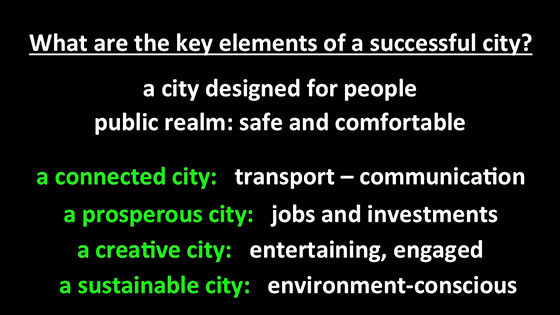
There are many good models for how we can make our city a better, more prosperous, climate-friendly and climate-resilient place. One Planet Living is one – Regenerative Cultures is another. There are Transition Towns, there is Permaculture. Lot’s of ideas at hand. What we need to help council with is create one that genuinely suits a broader section of Geelong’s residents, and with a perspective of 20-30 years.

At the end of all this talk about our future, I’d like to remind you that while we talk and think about our future in 2035–2045, the global temperatures keep rising. Fossil fuel emissions keep rising too. It is critical we find new ways to deal with the urgency and the seriousness of the situation we have put ourselves in with our collective ignoring the warnings from our climate scientists for decades.

For a start, I’d like to encourage everyone to sign the petition for a Climate Emergency Declaration – and at the same time as we acknowledge that we live in a dangerous era, also remember how Charlie Brown brilliantly framed it, when (in a cartoon) he said: “Worrying won’t stop the bad stuff from happening, it just stops us from enjoying the good.”

I am proposing that our future strategy for Geelong should be one which ensures that we can continue to pursue our various desires to enjoy the good life, only done in much more sustainable and environment-conscious ways than we do it today. Such a strategy could have the potential to become a powerful driver, motivator, change-maker in this city the years to come.
It seems to me this could be a perfect opportunity for us, the citizens of Geelong, to figure out how we get better at managing our long-term future goals.
» More on Facebook about Solar in Denmark | Waste-to-energy | Solar BBQ
Group workshop at Beav’s Bar

Participants at the brief ‘future workshop’ at Green Drinks at Beav’s Bar in Geelong
Discussion on Facebook
Quentin Farmar-bowers reacted on Facebook with a comment to the photos from Denmark:
“What people want in life in the long term is similar world over I think. Culture must make a difference but how electricity is generated, how informed the people are, how healthy and well fed the people are, how safe people are from violence, are a consequence of how alert and progressive all levels of government are, and this in my view depends on how people view the importance of evidence over ideology and self interest.
In Australia we seem to be going backwards into dismissing science and evidence as quackery and relying on myth and ideology to govern our future
Your photos show some of the outcomes of better thinking. I would like to know what is driving this more progressive way of thinking and what we can do in Australia at a personal / local community level to progress.
Why are these things happening in Denmark?”
Here are some of the replies his comment received:
“I think education plays a big part there. It is principally public education from a very young age (for some from 6 months old) and where organic produce is held in high regard and fed to children at day care/school and is seen as the norm. Parents follow suit and also then value that option too. Kids grow up wanting that product as its what they’re used to. As for wind energy, I think that is fairly entrenched in their culture too. Also, Danish people in general are more socialist oriented where there is greater value in the collective rather than an individual’s self interest. Anyway, Maybe some generalisations, but there are a few reasons that come to mind.”
Deb Aidt
“Being a Dane myself, I would like to share a few thoughts on this rather complicated subject. First of all, Denmark is not Paradise on Earth. Over the past few years there has been an increasing hyp about Denmark and Scandinavia in general. All the surveys showing that Danes are the happiest people on Earth and all. We see an increasing number of tourists in the country and Danish TV-shows are selling all over. Believe me – this was not the case 20 years ago. Anyway, we are getting used to a lot of positive attention. Therefore, it is important to remember that Denmark is just a country with its own history and culture as all other.
So, coming to the point, major movements in Denmark during the past 150 years have been the co-operatives in agriculture and the workers movements. Both were very much bottom-up movements created by people and not political leadership – though they have changed over the years. These movements turned Denmark away from the previous hierarchical society and lay the ground for todays welfare society.
What all this means is that we as Danes have prospered from working together to create wealth and the majority of the population has benefitted from the wealth creation because of the welfare system.
The fact most people benefit from the system means a huge support. It also means people in general are concerned about our shared resources such as our ground water. Preservation of ground water for the future is the reason legislators promote organic farming for example.
Harvesting wind has to do with utilising the resources we have and wind is abundant around here. There is much more to say about this topic.
This was was just a few important touch downs in recent Danish history which help to explain our way of doing things.”
Claus Strøeh
“Those things happened in Denmark long long time ago.”
Tony Di Palgi
“A few gems there, which could be published in the media. Sure Tony that those things happened “a long time ago” but history ripples and what you see today is remnants of the past, without the collective thinking of the past and the jantelov, DK would have looked different. I think culture has ALWAYS been influenced a LOT more by other countries than we think – Denmark has been quite efficient in taking on foreign thoughts, although “we are always the best” is at the back of every Danes mind. Globalization is not new to DK, it just goes a helluva lot faster nowadays! Wind – you wonder how much the government/state has invested in this technology (indirectly) – but that may never be possible to calculate”
Erik Thorup
“Okay let me be more precise. I visited Denmark first time when I was 17 or 18 & the windpower was already then there. Now I’m 34 & living in Australia where government is funding research to find out whether windpower effects negatively on people’s health. There are more restrictions around renewables than around establishing new coalmine. Etc etc. So I think Denmark is doing pretty well. Plus the bike culture, public transport. Yes, I believe Denmark has it’s own problems – but seriously now… Don’t worry about Denmark’s changing culture… soon the rising sea levels will create that change. And when it comes to Australia then I love the naivity of Australians that started ~200 years ago. No joke. In Australia the problem is structural.”
Tony Di Palgi
“Choosing the Balanced Community”
“Everywhere in our society individuals, families and larger groups choose to abandon the Competition State and select the Balanced Community instead. They know that GDP with its one-sided focus on economic growth shouldn’t be the benchmark for their lives. They step off the hamster wheel and drop that uniform we are given as foot soldiers of the Competition State.
They wipe the slate clean and give a different and more sustainable future a chance. They move to the countryside, experiment with accommodation and finding new ways to balance work and family life, perhaps grow their own food or buy locally produced ingredients. They organise themselves differently, open a private school, several generations live under the same roof, they put solar panels up or operate an organic grocery store together in the old community hall, which has long been closed.
Similarly, companies are on the move. New concepts and business models are being developed, the technology provides endless opportunities. Restaurants sell surplus food, supermarkets stop packaging the goods in costly packaging, open their doors. Giants like LEGO and Novo Nordisk raise wind turbines or set and achieve ambitious reduction targets for their climate impact. Entrepreneurs find new solutions that make sense on both economic, social and green bottom lines.
So we are already well underway. We are on the way from a society where the economy is the goal to a society where the economy is the means to create a good life. Because life, goddamn it, got to make sense and be meaningful. That is supposedly why we are here.”
~ Uffe Elbæk, leader of the Danish political party The Alternative

This is the timeline for the community consultation process in Geelong
About ‘Our Future’ project
City of Greater Geelong writes on their home page:
“We all recognise the potential of Geelong. Our Future will capture this potential, and guide decision making and investment in our municipality into the future.
We need to consider what we could be in 30 years time. What do we need to be a thriving, inclusive and sustainable city? How do we stay globally competitive? How do we meet the emerging needs of the community, whilst addressing environmental, economic and demographic changes?
Our Future will be based on the community’s ideas and hopes for what Geelong could be in 30 years from now.
What is Our Future?
- We will create a visual picture of what Geelong will look like in 30 years from now.
- It will be aspirational – anything is possible.
- It will capture your ideas on what you want for the future
- It will guide decision-making at a council, government, business and community level.
How we’ll create Our Future
Council is aiming for 25,000 contributions from residents, community, business and industry stakeholders and people connected to Geelong what they think our future could be.
- Everyone has something they can contribute and a role to play in creating Our Future and turning it into reality.
- We’ll find out what makes a city great and what changes we can expect in the future, both globally and locally. We’ll share this information with you, so you can make informed suggestions about the future.
There are five stages to the project:
| Stage 1: | Inspire, educate and consult (September – December 2016): We’ll share ideas on global trends that could impact us in the future and ideas on what makes a great city. We’ll ask what you think Geelong could look like in 30 years from now, and what you want it to look like. Read more about how you can get involved. |
| Stage 2: | Sorting through the ideas (November – December 2016): Sort ideas and present back to the community. |
| Stage 3: | Community feedback (January – March 2017): Community comments on ideas presented. |
| Stage 4: | Final analysis (March – April 2017): Collate community ideas into final document. |
| Stage 5: | Public exhibition (May 2017): Visual presentation of the Our Future project. |
How Council will keep Our Future relevant
Council intends to keep having conversations with the community and stakeholders about Our Future after May 2017. The vision will be monitored and reviewed on a regular basis alongside ongoing community engagement.
» www.geelongaustralia.com.au/ourfuture
» Listen to a 20-minute radio interview with Dr Kathy Alexander, the city council’s Chair of Administrators, in The Sustainable Hour
“Successful global cities of the future have four huge challenges to address – the increasing impact of climate change, global economic uncertainty and its inherent impact of social equity and inclusion, population growth and rapid technological advancement.”
Dr Kathy Alexander
» What could Geelong be?
By City of Greater Geelong Chair of the Administrators, Dr Kathy Alexander

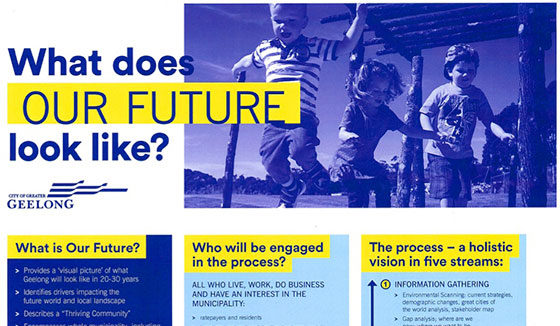
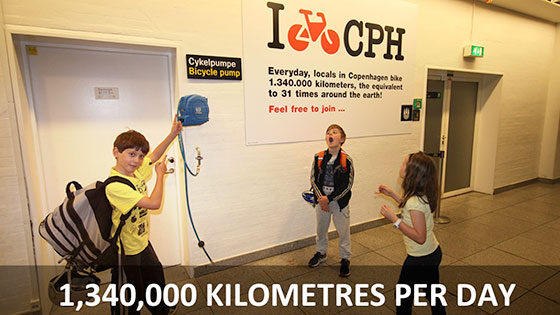
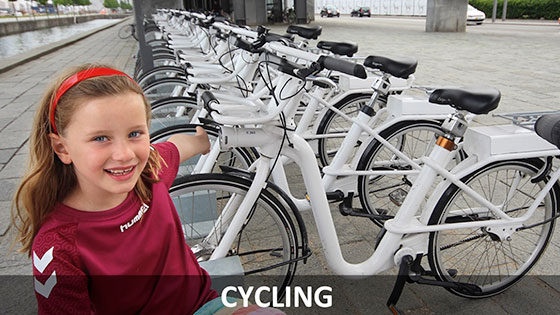




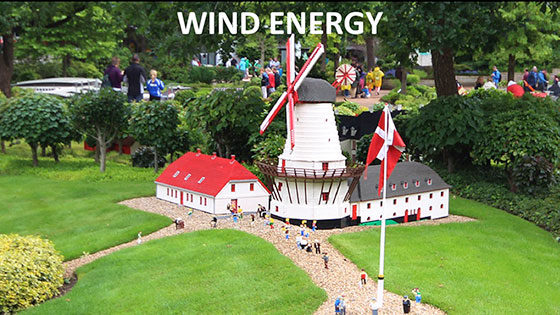


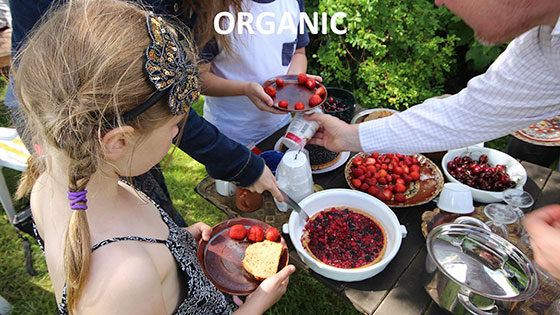

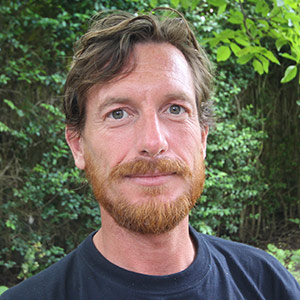



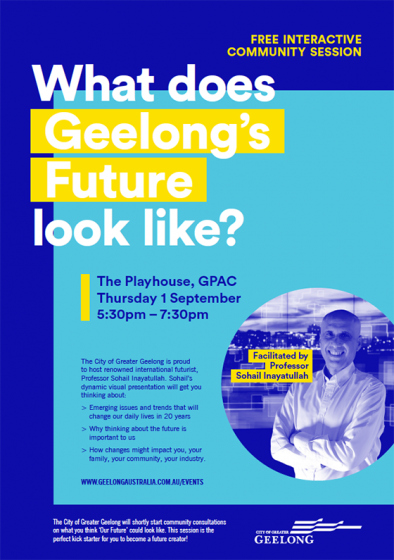

We often talk about all the aspects of riding around Geelong… But we rarely touch on climate change – this big fat hairy gorilla will be the biggest challenge we face as a residents of planet Earth over the next 25 years…
Of course everyone knows bike transport is zero emissions and encouraging it is worthwhile for about a million reasons and very positive for today’s society.
What is not considered is what governments will impose on people when they decide it’s time to take on the big hairy beast… Will it mean carbon taxes, big fat fuel taxes, emissions taxes, banning diesel cars, taxes on car purchases, car free days, tax exemptions for riders or complete car free cities… These issues are being considered now in cities across the world. We have to be part of it.
Geelong can be forward looking or reactive. We can be innovators or we can be content with business as usual. Is the rapid change of society going to be steady or will it feel like falling off a cliff.
Progressing more sustainable transport is one way of future proofing Geelong today for tomorrow’s world.
Bicycle Users Geelong
http://www.facebook.com/bicycleusersgeelong